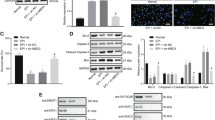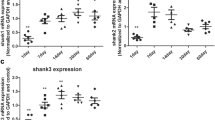Abstract
Epileptogenesis, induced by status epilepticus (SE), is a chronic process, and intervention in this progress may prevent chronic epilepsy. It has been proposed that DNA methylation might be related with epileptogenesis. RASgrf1 has a differentially methylated region at the promoter which can silence gene expression. We have previously observed the down-regulation of RASgrf1 in epilepsy patients and proved that hypermethylation of RASgrf1 reaches maximal level at the latent period in mice after kainate-induced SE (KA mice), with corresponding alteration of RASgrf1 expression. In the present study, N-phthalyl-L-tryptophan (RG108), a DNA methyltransferase inhibitor, was applied in KA mice at latent phase and the behavior, electroencephalogram and pathological changes were observed in chronic phase. Methylation and expression of RASgrf1 were determined by polymerase chain reaction (PCR), western blotting, and bisulfite sequencing PCR. The results showed that the incidence of spontaneous recurrent seizures (SRS) was significantly lower in the RG108 group than the normal saline (NS) group. Subgroup analysis showed significant hypermethylation and lower expression of RASgrf1 in the RG108–SRS subgroup and the NS–SRS subgroup but not in the RG108–NSRS (no SRS) subgroup and the NS–NSRS subgroup compared with the control group. No significant difference was found between the RG108–SRS and NS–SRS subgroups. Meanwhile, hippocampal neuronal loss was observed in RG108–SRS and NS–SRS subgroups. We thus demonstrated that RG108 could modify the progression of epileptogenesis after KA induced SE and prevent chronic epilepsy. Meanwhile, hypermethylation of RASgrf1 after KA induced SE could be reversed with corresponding changes of RASgrf1 expression. Additionally, we speculated that RASgrf1 might be a potential epigenetic mediator in epileptogenesis and chronic epilepsy.




Similar content being viewed by others
References
Brodie MJ (2016) Pharmacological treatment of drug-resistant epilepsy in adults: a practical guide. Curr Neurol Neurosci Rep 16(9):82
Pitkanen A, Lukasiuk K (2011) Mechanisms of epileptogenesis and potential treatment targets. Lancet Neurol 10(2):173–186
Goldberg EM, Coulter DA (2013) Mechanisms of epileptogenesis: a convergence on neural circuit dysfunction. Nat Rev Neurosci 14(5):337–349
Younus I, Reddy DS (2017) Epigenetic interventions for epileptogenesis: a new frontier for curing epilepsy. Pharmacol Ther 177:108–122
Hwang JY, Aromolaran KA, Zukin RS (2013) Epigenetic mechanisms in stroke and epilepsy. Neuropsychopharmacology 38(1):167–182
Kobow K, Blumcke I (2012) The emerging role of DNA methylation in epileptogenesis. Epilepsia 53(Suppl 9):11–20
Henshall DC, Kobow K (2015) Epigenetics and epilepsy. Cold Spring Harb Perspect Med. https://doi.org/10.1101/cshperspect.a022731
Wang L et al (2016) DNA methylation profiling reveals correlation of differential methylation patterns with gene expression in human epilepsy. J Mol Neurosci 59(1):68–77
Miller-Delaney SF et al (2015) Differential DNA methylation profiles of coding and non-coding genes define hippocampal sclerosis in human temporal lobe epilepsy. Brain 138(Pt 3):616–631
Kobow K et al (2013) Deep sequencing reveals increased DNA methylation in chronic rat epilepsy. Acta Neuropathol 126(5):741–756
Miller-Delaney SF et al (2012) Differential DNA methylation patterns define status epilepticus and epileptic tolerance. J Neurosci 32(5):1577–1588
Krapivinsky G et al (2003) The NMDA receptor is coupled to the ERK pathway by a direct interaction between NR2B and RASgrf1. Neuron 40(4):775–784
Zhu Q et al (2013) Decreased expression of Ras-GRF1 in the brain tissue of the intractable epilepsy patients and experimental rats. Brain Res 1493:99–109
Chen X et al (2017) Association of RASgrf1 methylation with epileptic seizures. Oncotarget 8(28):46286–46297
Stafstrom CE, Thompson JL, Holmes GL (1992) Kainic acid seizures in the developing brain: status epilepticus and spontaneous recurrent seizures. Brain Res Dev Brain Res 65(2):227–236
Yang Y et al (2017) Chronic metformin treatment facilitates seizure termination. Biochem Biophys Res Commun 484(2):450–455
Hauser RM, Henshall DC, Lubin FD (2017) The epigenetics of epilepsy and its progression. Neuroscientist. https://doi.org/10.1177/1073858417705840
Beghi E (2003) Overview of studies to prevent posttraumatic epilepsy. Epilepsia 44(Suppl 10):21–26
Williams-Karnesky RL et al (2013) Epigenetic changes induced by adenosine augmentation therapy prevent epileptogenesis. J Clin Invest 123(8):3552–3563
Zhu Q et al (2012) Increased expression of DNA methyltransferase 1 and 3a in human temporal lobe epilepsy. J Mol Neurosci 46(2):420–426
Nelson ED, Kavalali ET, Monteggia LM (2008) Activity-dependent suppression of miniature neurotransmission through the regulation of DNA methylation. J Neurosci 28(2):395–406
Levenson JM et al (2006) Evidence that DNA (cytosine-5) methyltransferase regulates synaptic plasticity in the hippocampus. J Biol Chem 281(23):15763–15773
Machnes ZM et al (2013) DNA methylation mediates persistent epileptiform activity in vitro and in vivo. PLoS ONE 8(10):e76299
Zippel R et al (1997) Ras-GRF, the activator of Ras, is expressed preferentially in mature neurons of the central nervous system. Brain Res Mol Brain Res 48(1):140–144
Acknowledgements
This work was supported by the National Natural Science Foundation of China (Grant Numbers 81071040, 81471320).
Author information
Authors and Affiliations
Corresponding authors
Ethics declarations
Conflict of interest
None of the authors has any conflicts of interest to disclose.
Rights and permissions
About this article
Cite this article
Bao, Y., Chen, X., Wang, L. et al. RASgrf1, a Potential Methylatic Mediator of Anti-epileptogenesis?. Neurochem Res 43, 2000–2007 (2018). https://doi.org/10.1007/s11064-018-2621-9
Received:
Revised:
Accepted:
Published:
Issue Date:
DOI: https://doi.org/10.1007/s11064-018-2621-9




